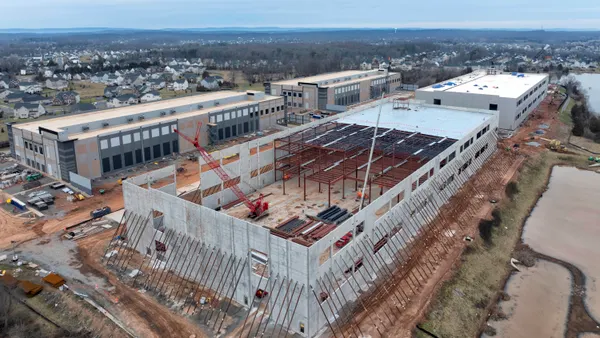Dive Brief:
- Scientists from the U.S. Department of Energy's Lawrence Berkeley National Laboratory have discovered how to print 3-D structures comprising liquids, according to a news release from Berkeley Lab.
- By way of a modified 3-D printer, scientists inject threads of water into silicone oil — essentially sculpting tubes made of one liquid within another liquid. Researchers attribute this advance to learning how to create liquid tubes inside another liquid and then automating the process.
- The material, which has been printed in threads from 10 micron to 1 millimeter in diameter and up to several meters in length, could be used to construct liquid electronics that power flexible, stretchable devices.
Dive Insight:
Prior to the Berkeley Labs breakthrough, 3-D printing, sometimes referred to as additive manufacturing, was limited to working with solid materials, such as concrete. Even so, those solid materials offer scientists plenty of space in which to innovate.
HP last month introduced a series of printers that not only print in color, but also print with multiple materials simultaneously. This is done through voxel control; a voxel is a 3-D pixel the printers use to create objects and voxel control is what allows the printer to change the material being used to produce the final object.
The 3-D printing technology also could be instrumental onsite. Last December RCAM Technologies received a $1.25 million grant from the California Energy Commission to develop and test 3-D printing technology to construct concrete turbine towers onsite. This onsite method could yield 140-meter-tall towers. Comparatively, steel towers that must be transported to the site are only 80 meters high; the challenges of transporting these structures over roadways restricts the ability to use taller ones.
Magued Eldaief, CEO of BIM hardware-software technology company Prescient, sees not only automation and robotics continuing to infiltrate jobsites, he told Construction Dive last month, but 3-D printing as well.
"I believe 3-D printing will also play a big role as the cost and limitations of that technology evolve," he said. All of those technologies will contribute to enhancing site productivity and eliminating human safety concerns.
Houses, too, will experience more 3-D printing innovation. Startup ICON, in partnership with nonprofit New Story, plan to use 3-D printing to build 100 printed homes in El Salvador by the end of the year. A printer designed especially for this project will manufacture a single-story, 650-square-foot concrete house in less than 24 hours.













